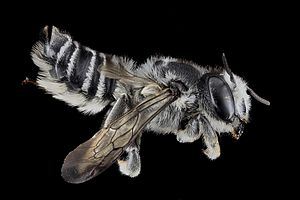Texas leafcutter bee facts for kids
Quick facts for kids Texas leafcutter bee |
|
|---|---|
 |
|
| Scientific classification | |
| Genus: |
Megachile
|
| Species: |
texana
|
The Texas leafcutter bee, also known by its scientific name Megachile texana, is a fascinating type of bee. It belongs to a group of bees called Megachilidae, which are known for how they build their nests. An American scientist named Ezra Townsend Cresson first officially described this bee in 1878. You can find the Texas leafcutter bee living in many parts of the United States and southern Canada.
Contents
What Does the Texas Leafcutter Bee Look Like?
Texas leafcutter bees are fairly small. Female bees are usually between 11 and 13 millimeters long. This is about half an inch. Male bees are a little smaller. They are typically between 10 and 12 millimeters long.
Bee Body Features
The head and middle part of the bee's body, called the thorax, are covered in short, thick whitish hair. Their wings are clear, almost like glass. You can see dark lines, or veins, running through them. The back part of the bee's body, called the abdomen, has stripes. These stripes are black and yellowish-white.
The Life of the Texas Leafcutter Bee
Texas leafcutter bees are known for how they build their homes. They often make their nests in grassy areas. You might find a nest entrance under a rock. It could also be under a clump of dirt. Sometimes, they even build nests on a small mound of earth.
Building a Nest
The tunnels they dig can be quite long. Some burrows go as deep as 25 centimeters (about 10 inches). Often, the top of the tunnel is the underside of a flat stone. These bees sometimes use holes that are already there. However, female bees have also been seen digging their own new nests.
Inside the Nest
A bee might build just one special room, or cell, in its nest. Sometimes, it builds several cells. Each cell is carefully lined with pieces of leaves. The bee cuts these leaf pieces itself. This is similar to how other leafcutter bees, like the Megachile rubi, build their nests.
From Egg to Bee
Each cell is filled about halfway with a mix of pollen and nectar. This mixture is food for the young bee. The female bee then lays a single egg on top of this food. When the egg hatches, a larva (a grub-like stage) appears. The larva eats all the food. Once it has grown enough, it changes into an inactive stage called a prepupa. This prepupa then forms a cocoon. The cocoon fills the cell. The outside of the cocoon is wrapped with brownish threads. This protects the developing bee inside.

